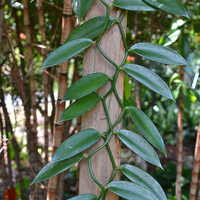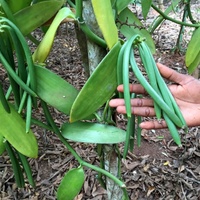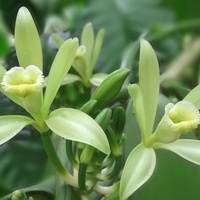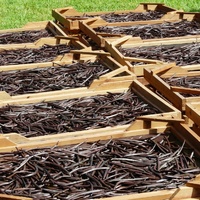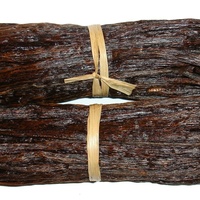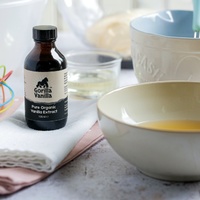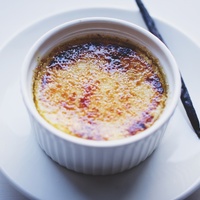Common name: Vanilla
Other common names: Bourbon vanilla
Description
Native to southern Mexico and neighbouring Guatemala, this orchid produces seedpods that are the source of vanilla, one of the world's best-known and most widely used flavourings. Its habitat is humid tropical forests, where it grows in the shade of closely spaced trees, away from direct sunlight.
It is a perennial vine with herbaceous stems that climb supported by aerial roots, which arise at nodes along their underside. The aerial roots cling to structures they climb on, usually a tree trunk, supporting the vine as it grows and at the same time taking up moisture and nutrients to nourish the plant.
Individual vines in the wild may be up to 30 m (100 ft) long but are more commonly 5 to 15 m (16 to 50 ft) in cultivation and are either branched or unbranched. They have thick, fleshy stems that are dark green and photosynthetic like the leaves, absorbing sunlight that filters through the forest canopy above.
Leaves are lance-shaped, 10 to 20 cm (4 to 8 in) long, dark green and fleshy. They are borne alternately along the stem at nodes opposite the aerial roots, which fasten themselves to the tree trunk.
The flowers are large, 5 to 8 cm (2 to 3 in) wide, orchid-like with ruffled lips, pale green or yellow and set in three to five yellow-green sepals. They are held in clusters of ten to twenty, occasionally up to thirty, borne near the top of the stems but with only one to three flowers opening each day. These are pollinated naturally by a bee species found only in the plant's native range, making hand-pollination the only viable alternative elsewhere. Otherwise, few if any flowers develop seedpods.
Fertilised flowers develop into smooth, green-skinned tubular seedpods 10 to 25 cm (4 to 10 in) long. They mature about seven to ten months after fruit-set, becoming pale yellow with many tiny, roundish seed inside.
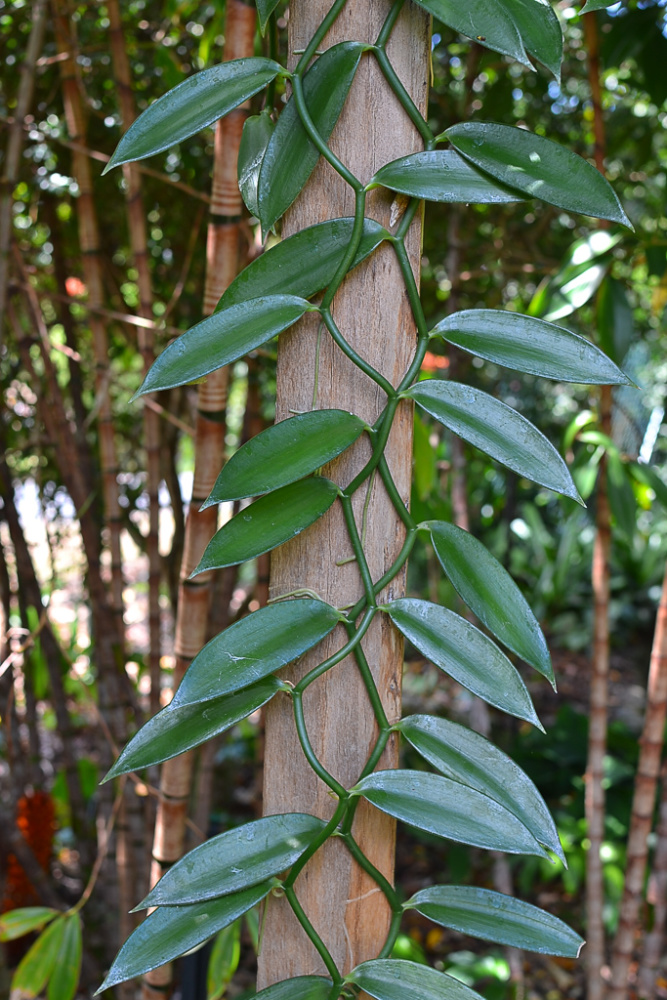
Vanilla vine (Cairns, Australia)
Use
Vanilla flavouring comes from the seedpod, which, when harvested and allowed to sweat (ferment) under controlled conditions, produce what is commonly known as the 'Vanilla bean'.
The traditional process involves immersing the mature beans in near-boiling water to kill them. Then they are sweated (fermented), which causes them to change colour, becoming dark brown or brown-black. As it darkens, the bean loses moisture and wilts, becoming wrinkled through the process and develops its rich vanilla flavour and aroma.
Vanilla has long been used for flavouring food, first by the ancient Aztecs, who discovered it up to the present day where it is used to flavour many sweet dishes, the best-known of which is probably vanilla ice cream. Apart from ice cream, vanilla flavouring is used in cakes, puddings, custards, chocolate, beverages and medicines.
It is also used as a fragrance in air fresheners and soaps and has become one of the most widely used perfume ingredients, appearing in the top notes of near a quarter of all high-quality perfumes, including 'L' Aimant' by Coty, 'Bois des Iles' by Chanel, 'Jicky' by Guerlain, 'Habanita' by Molinard and 'Amouage'.
An extract of vanilla can be made by removing the seed from the pod and soaking it in unflavoured, colourless alcohol, such as vodka, for at least four weeks, preferably in a glass bottle kept in the cupboard and shaken once a day. Vanilla extract can also be found for sale in supermarkets, usually in the baking aisle.
Climate
Grows and flowers naturally in humid subtropical and tropical climates, generally frost-free areas with annual lows of 18 to 25°C, annual highs of 27 to 35°C, annual rainfall of 1200 to 4300 mm and a dry season of 4 months or less. Vanilla vines may fail to thrive in areas where the average low of the coldest month is below 14°C (50°F).
Although also cultivated in cooler climates in greenhouses, the climate data above only references areas where vanilla thrives outdoors.
Growing
New plants are usually started from stem cuttings 0.9 to 1.2 m (3 to 4 feet) long. The severed end and one node are buried in free-draining soil, and the exposed length is tethered to a support structure for the vine to cling to and grow up on.
The planting site should be in filtered sun or light shade and the soil loose loam or sand enriched with organic matter, the pH in the 5.0 to 7.0 range. Mulching with lightweight organic material around the base, such as coconut husks, is recommended to maintain a moist soil in dry weather.
The vines start to flower around eighteen months to two years after planting and may produce a small crop seven to ten months later. The flowering season usually coincides with the rainy season, which is spring to summer in its native range.
Hand-pollinating is done in the morning while the flower is fresh. It involves removing the pollen masses with a toothpick or small instrument and moving it gently into contact with the stigma.
Problem features
The seedpods produce large quantities of tiny, viable seed easily dispersed by wind and flowing water. It is reported to have escaped cultivation and naturalised in Puerto Rico. And is assessed as a high weed risk species for Hawaii by the Hawaii Pacific Weed Risk Assessment (HPWRA) project.
The sap can cause skin irritations to some persons, usually occurring when trimming the vine.
Where it grows
References
Books
-
Adams, C. D. 1972, Flowering plants of Jamaica, University of the West Indies, Mona, Greater Kingston
-
Attokaran, M. 2011, Natural food flavors and colorants, Institute of Food Technologists, Wiley-Blackwell Publishing, Oxfordshire
-
Elevitch, C. R. & Thaman, R. R. 2011, Specialty crops for Pacific islands, 1st ed, Permanent Agriculture Resources, Hawaii
-
Farooqi, A. A. & Sreeramu, B. S. 2004, Cultivation of medicinal and aromatic crops, Hyderabad University Press, Hyderabad
-
Griffiths, M. & Burras, J. K. 1994, Manual of climbers and wall plants, Royal Horticultural Society (Great Britain), Timber Press, Portland, Oregon
-
Khan, I. A. & Abourashed, E. A. 2010, Leung's encyclopedia of common natural ingredients : used in food, drugs and cosmetics, 3rd edition, Wiley Publishing, Hoboken, New Jersey
-
Macmillan, H. F. 1943, Tropical planting and gardening : with special reference to Ceylon, 5th ed, Macmillan Publishing, London
-
Norrington, L. & Campbell, C. 2001, Tropical food gardens : a guide to growing fruit, herbs and vegetables in tropical and sub-tropical climates, Bloomings Books, Hawthorn, Victoria
-
Perkins, K. D. & Payne, W. 1981, Guide to the poisonous and irritant plants of Florida, Florida Cooperative Extension Service, Gainesville, Florida
-
Purseglove, J. W. 1981, Tropical crops: Monocotyledons, Longman, Harlow, London
-
Randall, R. P. 2002, A global compendium of weeds, R.G. and F.J. Richardson Press, Melbourne
-
Randall, R. P. 2007, The introduced flora of Australia and its weed status, Cooperative Research Centre for Australian Weed Management, Glen Osmond, South Australia
-
Stewart, A. 2013, The drunken botanist : the plants that create the world's great drinks, 1st ed., Algonquin Books, Chapel Hill, North Carolina
-
Weiss, E. A 2002, Spice crops, CABI Publishing, Wallingford, United Kingdom
Articles, Journals, Reports and Working Papers
-
Watson, B.J., & Moncur, M. 1985, Guideline criteria for determining survival, commercial and best mean minimum July temperatures for various tropical fruit in Australia (Southern Hemisphere), Department of Primary Industries Queensland (DPI QLD), Wet Tropics Regional Publication, Queensland
